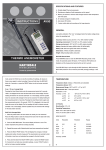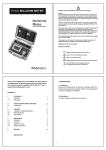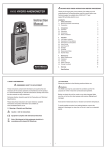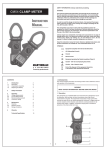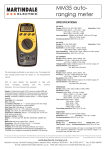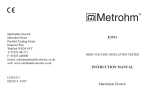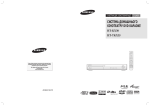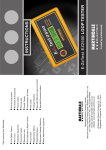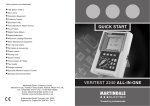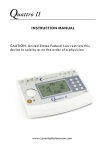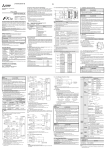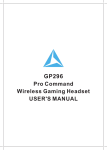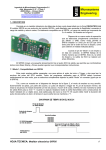Download Manual - Martindale Electric
Transcript
Metrohm Martindale Electric Metrohm House Penfold Trading Estate Imperial Way Watford WD24 4YY T: 01923 441717 F: 01923 446900 Email: [email protected] web: www.martindale-electric.co.uk E3640 FLASH TESTER INSTRUCTION MANUAL LITE3640 ISSUE 7 07/07 Martindale Electric Co Ltd. ® Martindale Electric Co Ltd reserves the right to discontinue models at any time, or to change specifications, price or design, without notice and without incurring any obligation. LIMITED WARRANTY TABLE OF CONTENTS PAGE Martindale Electric Co Ltd warrants instruments and test equipment manufactured by them to be free from defective material or factory workmanship and agree to repair or replace such products which, under normal use and service, reveal the defect to be the fault of our manufacturing, with no charge for parts and service. If we are unable to repair or replace the product, we will make a refund of the purchase price. Consult the Instruction Manual for instructions regarding the proper use and servicing of instruments and test equipment. Our obligation under this warranty is limited to repairing, replacing or making refund on any instrument or test equipment which proves to be defective within 24 Months from the date of original purchase. Proof of purchase may be required.This warranty does not apply to any of our products which have been repaired or altered by unauthorised persons in any way so as, in our sole judgement, to degrade their stability or reliability, or which have been subject to misuse, abuse, misapplication, negligence or accident,or which have had the serial numbers altered, defaced or removed. Accessories, not of our manufacture, used with this product are not covered by this warranty. 1. SAFETY RULES 1 2. DESCRIPTION 2.1 GENERAL 2-3 2.2 CONTROLS 3-5 3. INSTRUCTIONS FOR USE 3.1 PRELIMINARY CHECKS 5-6 3.2 PERFORMING A TEST 7 4. APPLICATIONS 4.1 PRELIMINARY CHECKS 5. TECHNICAL SPECIFICATION 5.1 ELECTRICAL 8-9 5.2 MECHANICAL 9-10 5.3 ENVIRONMENTAL 10 6. SPARES AND ACCESSORIES 10 7. LIMITED WARRANTY 11 To register a claim under the provisions of this warranty, return the instrument or test equipment to Martindale Electric Co Ltd., Metrohm House, Penfold Trading Estate, Imperial Way, Watford WD24 4YY, UK. Upon our inspection of the product, we will advise you of the outcome of your claim. ALL WARRANTIES IMPLIED BY LAW ARE HEREBY LIMITED TO A PERIOD OF 24 MONTHS, AND THE PROVISIONS OF THE WARRANTY ARE EXPRESSLY IN LIEU OF ANY OTHER WARRANTIES EXPRESSED OR IMPLIED. The purchaser agrees to assume all liability for any damages and bodily injury which may result from the use or misuse of the product by the purchaser, his employees, or others, and the remedies provided for in this warranty are expressly in lieu of any other liability that Martindale Electric Co Ltd may have, including incidental or consequential damages. 8 1 SAFETY RULES The E3640 has been designed with safety in mind. However, no design can completely protect against incorrect use. Electrical circuits can be dangerous and even lethal through lack of caution or poor safety practices. 1.1 Read the Instruction Manual carefully and completely so that you fully understand the instructions before using the tester Follow the instructions in the Manual for every test. Take all the recommended precautions. Never exceed the limits of the tester. Bump Test IEC 68-2-29 Vibration Test: BS EN 61010 - clause 8.3 Impact Test: BS EN 61010 - clause 8.2 Drop Test: BS EN 61010 - clause 8.4 5.3 ENVIRONMENTAL Operating Temperature: -15ºC to +55ºC 1.2 The device under test (DUT) must be de-energised and isolated before connections are made for any tests. Storage Temperature: -25ºC to +65ºC Operating Humidity: 80% RH at 40ºC 1.3 Check that the Power selector on the tester is set correctly. Cold Temperature: IEC 68-2-1 1.4 Always set the voltage control to RESET or set the power switch to OFF before connecting/disconnecting the earth test lead and the HV gun probe to/from the “DUT”. 1.5 The earth test lead and the HV gun probe must be clean and in good working order with no broken or cracked insulation. 1.6 The HV gun probe must always be held correctly, with fingers behind the guard. Never try to defeat the safety trigger mechanism. 1.7 Do not touch the “DUT” during testing with any part of the body. 1.8 Always use the recommended replacement fuses. Dry Heat: IEC 68-2-2 Damp Heat: IEC 68-2-3 Installation Category II: BS EN 61010 - Annex J Pollution Degree 2: BS EN 61010 - clause 3.7.3.2 6. SPARES AND ACCESSORIES Mains Power Supply Lead: MARTL205 Earth Lead: METDFH 0366 HV Gun Probe: METDFH 0369 1.9 Do not use the tester in wet conditions. 2.0 Please ensure the test lead is pushed fully into the test socket and locked in position prior to carrying out any tests. NOTE: This tester should only be used by a competent, suitably trained person. -2- -11- Trip Level Range: 0.3 to 3mA 50/60Hz Setting Accuracy: ±5% of full Trip Response Leakage: Will trip for fault duration >5mS but not for <100μS Breakdown: Will trip for fast transients of 30μS and above Safety: LVD:Meets BS EN 61010-1 EMC:Meets BS EN 50081-1 BS EN 50082-2 Output Terminal Characteristics: E3640 OUTPUT CHARACTERISTICS 2 DESCRIPTION 2.1 GENERAL The E3640 is an AC flash tester for leakage and breakdown testing. It is designed for voltage testing of electrical apparatus, components and insulating materials. The tester is housed in a rugged, moulded plastic case with integral carrying handle. The hinged detachable lid is fitted with a pouch which contains all accessories and the instruction manual. All operating functions are mounted on a panel underneath the protective lid. A two position power selector adjusts the tester to operate from 115 or 230V ±15% 50/60Hz. The tester has an output AC test voltage which may be set in the range 0 to 4kV by adjusting the voltage control. The mode select switch allows the selection of either breakdown, trip or burn. Leakage current passing through the “DUT” is detected. In the breakdown mode the high frequency current will cause the tester to trip. In the trip mode the tester will trip if the current exceeds the trip level setting (0 to 3mA) of the trip level control or if breakdown occurs. However, when the burn mode is selected the trip does not occur and the output voltage is maintained but it reduces as current increases. 5.2 MECHANICAL Case Dimensions: Case Material: Weight: 330 x 263 x 144mm ABS 4kg -10- When the tester trips the fail lamp will illuminate, a buzzer will sound and the ‘kVON’ lamp will extinguish. The output voltage will drop to zero but the output voltage and the leakage current at the instant of trip will be held on their respective displays. To reset the tester the voltage control is rotated anti-clockwise to the reset position. If the tester is switched on when the voltage control is not in the reset position the HV output is inhibited and the ‘kV ON’ lamp will not illuminate. Turning the voltage control to reset will activate the HV circuits. Maximum output voltages of 2.2kV and 4.2kV are set such that if these -3- limits are exceeded the output will shut down until the voltage control is turned to reset. Illuminated displays show that the tester is switched on and the ‘kV ON’ lamp indicates that high voltage may be present at the outlet. 4.APPLICATIONS The HV gun probe has been designed with operator safety as the prime consideration. The trigger for the retractable high voltage probe sleeve is situated behind the finger guard and the integral lead is terminated in a custom designed high voltage safety connector. The E3640 flash tester is ideal for flash and applied AC voltage testing of all kinds of electrical and electronic equipment and components. 2.2 CONTROLS (Fig. 1 Refers) 2.2.1 VOLTAGE This control adjusts the output of the electronic AC regulator between reset and maximum, 2kV or 4kV which ever is selected. The reset position is used to re-energise the high voltage output circuit after 4. 1 PRELIMINARY CHECKS Requirements for testing are contained in many British and International standards and in the sixteenth edition of the IEE Wiring regulations (BS7671). Testing is mainly carried out on factory assemblies, but if an on-site repair is carried out or a factory assembled item is fitted on site then the same tests are carried out. Please ensure the test lead is pushed fully into the test socket and locked in position prior to carrying out any tests. 5.TECHNICAL SPECIFICATION 5.1 ELECTRICAL Power Requirement: 230 Volts ±15% 50/60Hz 40VA selectable 115 Volts ±15% 50/60Hz 40VA selectable Fuses: 230V - 5x20mm 0.25A, HBC, Type F 115V - 5x20mm 0.5A, HBC, Type F Output Voltage Range: 0.2 - 2.2, 0.2 - 4.2kV 50/60Hz Output Voltage Accuracy: ± 2% of reading ± 1 digit Leakage Current Range: 0 - 5 mA (nominal) 50/60Hz in 10μA steps Leakage Current Accuracy: ±2% of reading ± 1 digit exceeding the maximum level or after power switch on. Reset is also used to reset the trip circuit after a failure of the “DUT”. 2.2.2 VOLTAGE SELECT A two way switch allows 0-2kV or 0-4kV to be selected. -4- -9- To clear the displays the output voltage control is returned to reset. NOTE: a) b) In the burn mode the trip circuit is inoperable and the tester will continue to drive current into a fault. The fault current is limited to a nominal 5mA and the output voltage will decrease with increase in current. In the breakdown mode if excessive current is drawn by the “DUT” the desired output voltage may not be achieved. The specification for the “DUT” would then have to be checked to decide on the validity of the test. The leakage current is not displayed in this mode. c) It is advisable to return the output voltage control to reset before switching off the tester. d) During applied voltage tests the current which flows into and across the surface of the “DUT” is the leakage current and is the resultant of two components:-resistive and reactive. Resistive current is that which flows as a result of losses in the insulation of the “DUT”. Reactive current is that which flows as a result of capacitance in the “DUT” and will increase with increase in capacitance. It must be taken into account when carrying out an applied AC voltage test. 2.2.3 MODE SELECT Three modes of operation are selectable. Breakdown:- The tester will trip should breakdown occur in the “DUT” (high frequency leakage currents). Trip:- This position switches in a level detector whose input is variable over the range 0 to 3mA. The tester will trip if the leakage current in the“DUT” exceeds the level that is set. The tester will also trip for breakdown. Burn:- The tester will not trip in this mode regardless of breakdown or leakage currents but the ‘burn' current is limited to a nominal 5mA. 2.2.4 TRIP LEVEL This control sets the level on the trip detector that must be exceeded before a failure of the “DUT” is indicated. 2.2.5 POWER INLET This multi-function item combines an IEC inlet with a double pole switch, fuse drawer and 115/230 volt mains power selector. 2.2.6 INDICATORS kV ON:A red lamp which indicates that the high voltage output circuit is energised. Fail:- e) If the voltage select switch is operated when the voltage control is not at the “Reset” position, the HV circuit will de-energise and it will be necessary to return the voltage control to “Reset” to reactivate the HV circuit. A red lamp which indicates that the “DUT” has failed and the trip has triggered. A buzzer sounds in unison with the fail lamp to give an audible indication that the “DUT” has failed. 2.2.7 DISPLAYS Output Voltage kV:- The voltage applied to the “DUT” is displayed and the value at failure is held until the tester is reset. Leakage Current mA:- Leakage current through the “DUT” is displayed and the value at failure is held until the tester is reset. -8- -5- 2.2.8 HIGH VOLTAGE SOCKET This unique safety socket has an interlock which prevents accidental disconnection of the HV gun probe lead. 3. INSTRUCTIONS FOR USE 3.1 PRELIMINARY PROCEDURE NOTE: OBSERVE ALL SAFETY RULES AT ALL TIMES. 3.1.1 The tester can be powered from 115 or 230V +15% 50/60Hz. Ensure that the power source available is compatible with the voltage setting on the tester. To change the setting, remove the fuse drawer using a small screwdriver and pull out the fuse holder. Fit a 5 x 20mm 0.25A type HBC fuse for 230 volt operation or a 0.5A of the same type for 115 volt operation. Insert the fuse holder so that the desired voltage shows in the drawer window, then replace the drawer. NOTE: If the voltage selector is not set correctly then the tester may be damaged. Connect the mains lead to the power inlet and plug it into a suitable power outlet. If the neon to the right of the inlet socket lights, reverse the plug in the socket 3.1.2 Select the mode of operation; either breakdown, trip or burn. Breakdown:- When this mode is selected the trip circuit responds to high frequency currents produced by arcing faults only. Note: If there is a short on the “DUT” there will be no indication on the displays and the trip mode should be selected. NOTE: Leakage currents are not displayed when the break down mode is selected. -6- Trip:- In the trip mode, mains frequency currents associated with leakage and short circuits and high frequency arcing currents that are produced by breakdown are detected. Set the trip level to the required current by adjusting the control potentiometer. Burn:- In this mode the tester will not trip regardless of any failure mode in the “DUT”. Current will continue to flow allowing faults to be traced by observing the resulting arcing. 3.2 PERFORMING A TEST 3.2.1 Attach the spade connector of the earth lead to the earth terminal ( ) on the tester and the crocodile clip to the earth (reference) point of the “DUT”. 3.2.2 Insert the HV gun probe into the HV socket and select 2kV or 4kV output voltage as required. 3.2.3 Set the voltage control fully anti-clockwise to reset and switch on the tester. The ‘kV ON’ lamp will illuminate indicating that the high voltage circuit is energised. 3.2.4 Touch the HV gun probe onto the test point of the “DUT” and slowly rotate the voltage control clockwise until the value indicated on the display reaches the recommended test voltage for the“DUT”. 3.2.5 Maintain this voltage for the desired length of time. If, during this test period, the voltage is steady and the failure indicators do not energise (fail lamp and buzzer) then the “DUT” has passed its test. The recommended test time is 1 minute according to BSEN 61010. 3.2.6 A failure of the “DUT” will result in the fail lamp illuminating and the buzzer sounding. The ‘kV ON’ lamp will extinguish but the voltage and leakage current at the instant of failure will by held on the displays. Measurements can then be recorded accurately for each item tested. -7-








